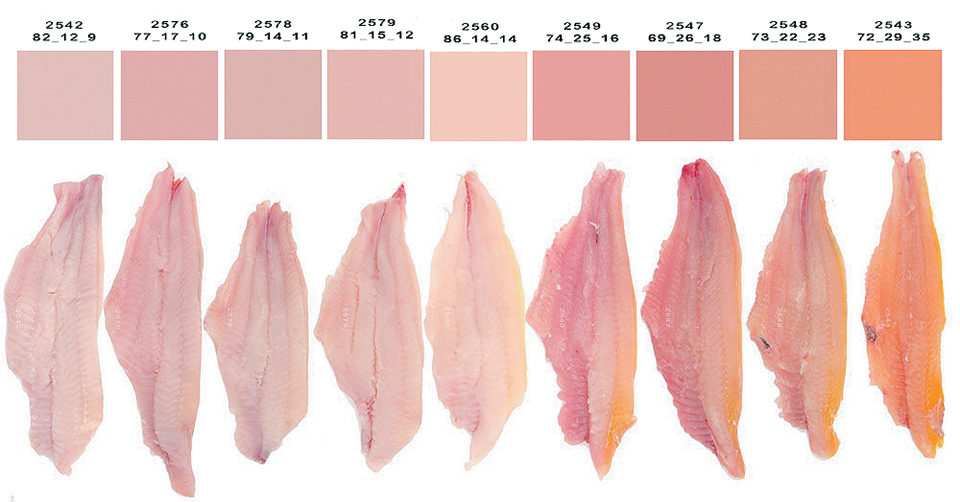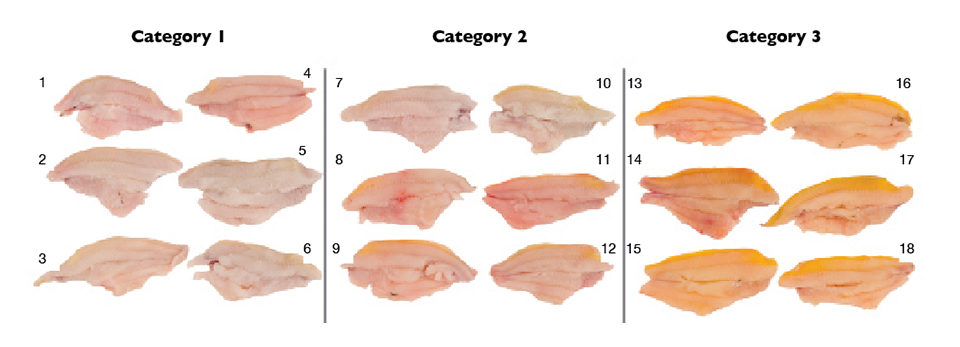Scale tool can be applied in refining quality

Although consumers have certain expectations about product color, current production and processing technology make it difficult to produce catfish fillets with consistent color. When people see catfish fillets in varying shades of pink, white and yellow in the seafood case, they often question which color represents the best or freshest product.
Color standards
There are no standards for optimum colors or color grades in use by the United States catfish industry at this time. The salmon industry, however, has dealt with this issue and can be used as a model for the color grading of other fish.
Salmon experts have developed standards and grades for both flesh color and skin color. Processing machinery can automatically evaluate each fillet and then calculate the most economic cut configuration based on size, shape and color grade parameters.
About color
Color is measured by a variety of methods. Regardless of the method employed, three components are necessary to see and evaluate color: a light source, an object and an observer.
Light sources vary in color, and objects appear differently under different lighting conditions. Our brains have adapted to this, but mechanical devices like cameras must be told how to measure light. Almost everyone has seen a photograph taken under fluorescent lights, in which peoples’ skin has a greenish hue, or a scene illuminated by candlelight, where things appear more yellow.
A light’s color or color temperature is expressed by a unit called the kelvin (K). This measurement is called a temperature is because it was derived from a theoretical object called a “black body radiator.” When the radiator is heated, it changes from black to red to yellow to white to blue. The lower the kelvin rating, the “warmer” or more yellow the light. At higher ratings, light is “cooler” or more blue. Kelvin ratings for common light sources are shown in Table 1.
Cline, Light temperatures, Table 1
| Light Source | Temperature (K) |
|---|
Light Source | Temperature (K) |
|---|---|
| Candle | 1,800 |
| Indoor tungsten | 3,000 |
| Indoor fluorescent | 4,000 |
| Outdoor sunlight | 5,500 |
| Outdoor shade | 7,500 |
| North sky | 28,000 |
Object, observer
For this article, the object of evaluation is the catfish fillet at the end of commercial filleting prior to additional treatment. Aspects such as the three-dimensional shape, color variations and color sheen of fillets can make color measurement more complex than with “flat” products like paint. To avoid hot spots or shine in the photos, the fillets must be evenly lit.
A person can be a very effective observer of color and able to distinguish many shades and hues. However, people perceive colors differently and with varying sensitivity. The author therefore chose to use a camera and properly calibrated software as an unbiased, accurate and consistent observer. This method has been in use for some time in the salmon industry, and has been evaluated as equal to if not superior to using a high-tech colorimeter.
Color evaluation of catfish fillets can also be conducted using a photo spectrometer, which takes a highly calibrated and sensitive measurement, but of only a very small area. The variability in catfish tissue makes this approach problematic because it only measures small portions of the whole. With the camera and calibration software, it was possible to account for both the amount and intensity of color over the entire fillet.

Photo procedure
For the authors’ procedure, catfish fillets taken directly from the processing line were placed on a uniform white cutting board and placed in a box made of translucent material to form a light cube. Two sides of the cube were lit using 3,150-K video spotlights. Sheets of white foam core were also placed under, in front of and behind the cube to avoid color contamination from nearby objects.
The fillets were photographed using a Canon 40D digital camera in the RAW image format. This format captures and maintains all information in the scene. JPEG-format images are typically analyzed and processed in camera by various algorithms, and the camera presents what it “thinks” you want. JPEG images are typically smaller in file size because some of the color data is compressed or discarded altogether.
Using the same lighting conditions, a photograph of a checkerboard array of standardized color patches called a color target was also captured. The color patches were “scientifically prepared” colors that represent natural colors like human skin, blue sky and green foliage. With this photograph and the color calibration software, it was possible to create a specific camera/lighting profile to use in the Photoshop program.
Photoshop scale
The photos were transferred to a computer and run through a series of steps using Adobe Photoshop image-editing software. Manipulation of Photoshop made it possible to digitally extract the fillet from the background and determine the average color of the fillets within the LAB “color space” of the software.
Results from the analysis allowed the authors to create a color spectrum for the fillets. Sample fillets from across the spectrum were used to create three primary color categories. The validity of the color categories was tested by asking industry experts to place 100 fillets into one of the three categories. There was only a 68 percent agreement among the members of the group regarding placement of the fillets.
Using the fillets with the highest agreement rates, a second version of the color chart was developed. Five groups of experts were then given identical sets of photographs of fillets and asked to place them into the three categories. There was a 92 percent agreement among the groups on which fillets fell into category one and 88 percent agreement on the other two categories.
The final result of the project was the “Cline Color Scale” for catfish fillets.
Perspectives
The catfish industry is facing many challenges in producing consistently high-quality, high-value products. This color scale is one tool that can be applied in refining catfish quality. Among the long-term goals of the catfish industry is the establishment of a set of best management practices that will provide catfish fillets of consistent color, flavor and texture.
In the meantime, this scale can be used by processing line workers to separate catfish fillets into categories for different markets. At a minimum, it makes it possible to get similarly colored fillets into the same box to avoid confusion at the retail level.
(Editor’s Note: This article was originally published in the July/August 2011 print edition of the Global Aquaculture Advocate.)
Author
-
David Cline
Aquaculture Specialist
Alabama Cooperative Extension System
203 Swingle Hall
Auburn University
Alabama 36849 USA
Tagged With
Related Posts

Innovation & Investment
Assessing coloration in channel catfish fillets
Because consumers look at color to gauge quality of catfish fillets, the authors developed a digital photography measurement method to assess yellowness.

Aquafeeds
A look at corn distillers dried grains with solubles
Corn distillers dried grains with solubles are an economical source of energy, protein and digestible phosphorus to reduce feed costs and fishmeal usage.

Innovation & Investment
Aquaculture Exchange: Flavio Corsin, IDH
IDH Vietnam Manager Flavio Corsin speaks passionately about the importance of controlling disease and getting all stakeholders to put competition aside and pull on the same end of the rope. Improvement initiatives for pangasius, shrimp and tilapia are among the Dutch sustainable trade organization’s priorities.

Responsibility
Aquaculture byproducts improve sustainability of seafood value chains
Tons of aquaculture byproducts are available as sources for fishmeal and fish oil to supplement the supplies obtained from fisheries. Innovative technologies are supporting more efficient use of these by-products in aquafeed.


